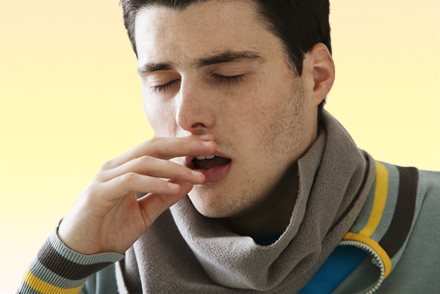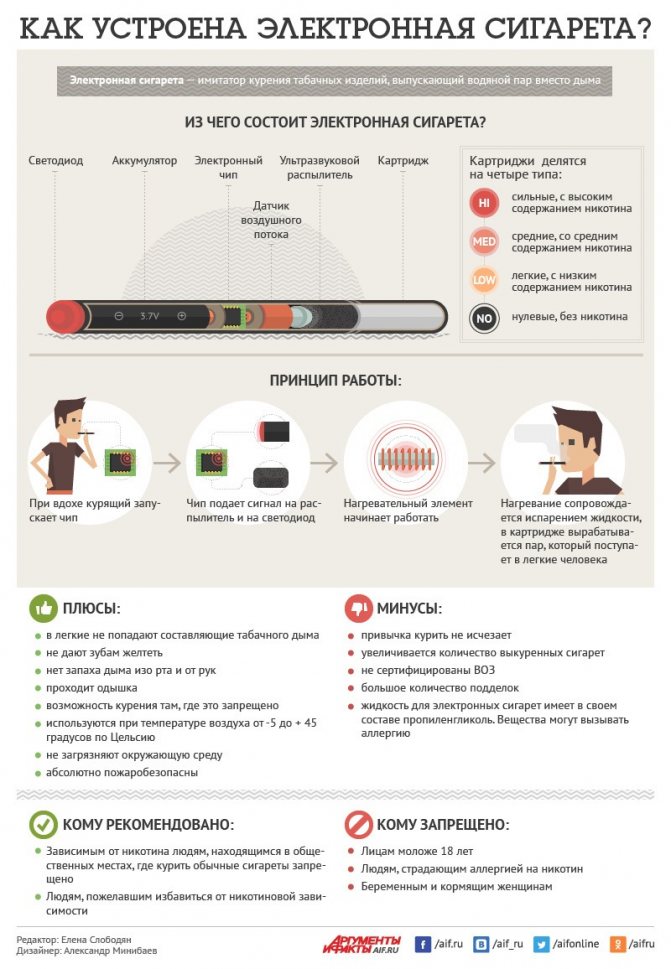Allergy to e-cigarettes is a relatively new phenomenon that is becoming increasingly common among people who like to smoke tobacco substitutes. Similar reactions are caused by many allergens: pollen, household chemicals, and so on. Therefore, it is not surprising that recently people have become allergic to electronic cigarettes.
The latter contains several chemical components that negatively affect the health of both the smoker himself and his environment.
Which electronic cigarettes cause allergies?
Today, the market offers many smoking devices that are designed for both one-time and long-term use. The choice of a person prone to individual sensitivity reactions is influenced not only by the classic list of characteristics: price, functionality, and comfort of use. Allergy safety is also important, which is questionable if the liquid contains the following:
- Flavorings.
- Dyes.
- Flavoring additives.
- Propylene glycol (PG).
- Glycerin.
All these components can cause the formation of sensitivity of a specific nature of sensitization or clinically similar reactions of pseudo-allergy, which are not associated with the activation of the protective mechanisms of the immune system. It is also worth remembering that low-quality liquids may contain additional ingredients that have toxin and allergen properties.
Potential Hazards
Allergic reactions are familiar to a very large number of people on this planet. Such manifestations can begin from early childhood on fabric, food, gas pollution or, conversely, pollen from plants that abound in the clean rural air. The nature of these reactions is always different and its causative agents are always different.
Let's look at the electronic cigarette and the potential dangers that may await an allergy sufferer when interacting with these devices. The very first thing that may come to mind is to look for potential danger in what directly penetrates the human body - that is, inhaled steam.
From the principle of operation of an electronic cigarette, we understand that we obtain vapor by heating the vaping liquid. So it is logical that first you need to consider the components of the liquid and look for the problem there.

The composition of e-cigarette liquid itself does not pose any danger.
A standard vaping liquid will consist of a maximum of 5 components:
- propylene glycol;
- nicotine;
- glycerol;
- distilled water;
- flavorings.
Among all of the above, the first potentially dangerous substance is nicotine. Indeed, this toxic substance, which has a detrimental effect on the human body, can cause quite severe allergic reactions. Allergic reactions to this substance can occur in both mild and very severe forms.
Mild manifestations occur in the form of the development of rhinitis or conjunctivitis. In this case, a person may experience the following symptoms:
- stuffy nose, runny nose, numerous sneezing when inhaling steam;
- watery eyes, itchy eyes or foreign body sensation;
- itching in the larynx and ears;
- cough;
- With prolonged exposure to an allergen, migraines and general weakness of the body may occur.
An allergy to nicotine can also manifest itself as dermatitis. More severe manifestations of nicotine allergy are atopic bronchitis and Quincke's edema.
Symptoms
Characterized by reactions from the skin, mucous membranes, respiratory and digestive systems. They are not always of an immunological nature; they appear immediately after contact with steam or several hours/days/weeks after the first episode of smoking.
Respiratory disorders
They are formed when the upper and lower parts of the respiratory system are affected. Symptoms of an allergy to e-cigarettes include:

- Nasal congestion, sneezing, feeling of dryness, swelling.
- Runny nose, discharge of clear, watery mucus in large quantities.
- Feeling of tightness and soreness in the throat.
- Discomfort while eating, swallowing, talking.
- An attack of shortness of breath, coughing, congestion in the chest combined with whistling dry rales in the lungs.
They are not always pronounced, more often they occur in the form of erased reactions; the patient is bothered by dryness in the nose and throat, pain when swallowing, which goes away after stopping smoking and drinking plenty of water. Sometimes a painful dry cough appears, it is extremely intrusive, and intensifies after inhalation of vaping steam. Episodes of difficulty breathing that characterize the development of asthma become more severe each time and may require emergency care.
Dermatological signs
These are different options for damage to the skin and mucous membranes accessible to external examination. An allergy to e-cigarette liquid manifests itself:
- redness and swelling of contact areas;
- a feeling of dryness, tightness, itching, burning;
- the appearance of a small rash in the form of spots, blisters;
- peeling of the skin.
Diagnostics
Confirming the role of electronic cigarettes in the occurrence of symptoms is not always easy and often requires a lengthy search for probable allergens, especially if the patient suffers from food intolerance or sensitivity to household triggers (dust, animal hair).
Questioning, inspection
From these stages the doctor begins the examination. In the presence of respiratory problems, the assumption of a connection with smoking seems natural, but if the reactions are limited only to skin symptoms, vaping is not always thought about. Therefore, focus the specialist’s attention on the fact that you use electronic cigarettes; this may set the right direction for the diagnostic search.

During the examination, the condition of the skin, mucous membranes, the nature and extent of rashes, peeling and other pathological changes are assessed. If you go to a medical facility after relief (cessation) of symptoms, describe them in detail to a specialist. Photographs will be a great help;
Skin tests
They involve applying special preparations containing allergens to the forearm or back. The contact area is scratched or gently pierced with a small sterile needle; The method of intradermal injection of a diagnostic solution is also practiced.
Tests are used to provoke symptoms of an allergic reaction and are needed to check for sensitivity to various “suspected” substances. They can only be performed by a specially trained doctor; they are not indicated for all patients; if the role of cigarettes in the development of disorders is undeniable (for example, its abolition led to the disappearance of all disorders) or the patient may react to contact with anaphylactic shock, it is better to choose another diagnostic method.
Often uninformative, especially when it comes to a pseudo-allergic reaction. However, with a true version of immunological sensitivity, it is possible to detect antibodies; these are protective complexes that have specificity and are aimed at eliminating a specific provocateur, and therefore indicate the presence of sensitization to it. During diagnosis, tests such as:
- Immunoenzymatic.
- Radioallergosorbent.
Some benefit can be obtained by assessing the data of a general blood test (in particular, the leukemia formula and the percentage of eosinophil cells). In practice, laboratory tests to detect sensitivity to e-liquid are rarely used and are considered an additional rather than a primary diagnostic method.
Symptoms of a reaction to nicotine or other components of a tobacco product can sometimes be confused with intolerance to other substances. A person may not eat any food or avoid contact with animals for years, but the reason for his poor health may be an allergic reaction to tobacco. To accurately determine the allergen, you need to see a doctor and undergo a full diagnosis.
The most common method for determining a hazardous substance is samples. Testing is carried out only after symptoms completely disappear. The allergist applies one drop of potential solutions containing specific allergens to the skin and lightly scratches the top layer with a disposable needle.
We recommend
Nicotine poisoning: symptoms, first aid and overdose treatment methods
Atopic bronchitis

It is also called allergic bronchitis. Develops when nicotine enters directly into the lungs. The acute form of the disease is characterized by a paroxysmal cough, which most often appears at night or immediately after steaming.
This cough is often accompanied by shortness of breath and shortness of breath. Along with a cough, you may experience a runny nose, skin rash, nasal congestion, or headache.
READ MORE: Botulism: symptoms and treatment of the disease
With this disease, the body temperature will remain normal, which will allow you to distinguish this disease from infectious diseases of the respiratory system. Shortness of breath will most often be observed with increased physical activity.
Treatment
Individual sensitivity to e-cigarettes is persistent and cannot be eliminated by taking medications or other therapies. However, it is possible to significantly improve the patient's condition with the help of several measures.
Elimination

This is done in two ways:
- complete refusal to use vapes;
- if you are sensitive to certain components, replace the cigarette liquid with a version that does not contain provocateurs.
Thus, people who report an adverse reaction to propylene glycol (PG) can purchase solutions with glycerin and vice versa. Mixing these ingredients should be avoided. It is better to give preference to unflavored types without dyes or irritating additives (including menthol). The emphasis is on the individual selection of liquid for smoking, so you should first of all pay attention to your well-being after a new purchase or replacement.
This is the most famous group of antiallergic drugs today, which are used to relieve the main symptoms of intolerance reactions. They are available in tablets, injections, and also in forms for local application: drops (nasal, eye), ointments, lotions. May be recommended by a doctor for a course of treatment to eliminate acute disorders:
- Severe swelling.
- Itching.
- Rash.
The most popular means are:
- Eden;
- Erius;
- Cetrin;
- Fenistil;
- Zyrtec.
They are used only in cases of severe allergic reactions, pronounced resistance of pathological manifestations to the effects of antihistamines, and the development of asthma (including attacks of shortness of breath and cough). Classified as:
- systemic (most often used in the form of injections);
- topical, or local (applied locally on the skin, in the respiratory tract).
Glucocorticosteroids (Prednisolone, Elokom) are synthetic analogues of adrenal hormones. They cannot be used as self-medication, as there is a risk of a number of complications. In addition, it is important to calculate the dosage correctly, especially at the beginning and end of the course, this can only be done by a qualified doctor.
The most effective way to treat a tobacco allergy is to eliminate the cause, that is, stop smoking. If the reaction develops rapidly, it is necessary to take urgent measures: inject an antihistamine and call an ambulance. Before the arrival of doctors, you need to consult with the dispatcher about what else can be done to alleviate the patient’s condition.
For less noticeable manifestations of allergies that can worsen the quality of life, treatment is prescribed by a dermatologist or allergist. Antihistamines usually help relieve symptoms, the dosage and duration of use of which should be calculated by a specialist. The most common drugs in this group are Suprastin, Loratadine, Astemizole. These medications have many contraindications and side effects. They can only be used under medical supervision.
Dermatologists often prescribe medications to detoxify the body. Among them, activated carbon, Enterosgel, Polysorb and others are very popular. Smokers with respiratory tract damage are prescribed bronchodilators to eliminate a dry, irritating cough, for example, Salbutamol.
To avoid the recurrence of allergy symptoms, you must quit smoking and also avoid inhaling tobacco smoke. If there are smokers in the family, it is necessary to convince them to quit the addiction for the sake of maintaining health. If one of your relatives is susceptible to allergies, there is a high probability of its manifestation in other family members.
To successfully treat an allergy to nicotine, regular or electronic cigarettes, the very first thing you need to do is to completely stop smoking. If an allergic reaction is caused by intolerance to nicotine, then drugs that contain this substance, even in small doses, cannot be used to get rid of a bad habit.
You will also have to avoid places where others smoke, that is, protect yourself from the role of even a passive smoker.

Since clothes, upholstered furniture, and other household items easily absorb nicotine, you will need to thoroughly clean the house and wash things that smell of tobacco smoke.
For medical treatment, the following groups of drugs are used:
- antihistamines - help cope with allergic symptoms, act as anti-inflammatory drugs, help restore the functioning of the immune system, it is best to choose second or third generation drugs;
- anti-inflammatory - prescribed only by a doctor if the allergy is severe;
- symptomatic - when an allergy leads to serious consequences (skin diseases, respiratory diseases such as bronchial asthma), then these diseases, in addition to the allergy itself, need to be treated.
The most widely used antihistamines in the treatment of cigarette allergies are:
- Xyzal - depending on the form of release, adults can take it once a day, one tablet or 20 drops;
- Claritin - can be taken once a day, regardless of meal time - for adults, one tablet;
- Tavegil - for adults, you can take one tablet per day, 3 times a day;
- Loratadine - for adults with allergies, the daily dose is one tablet, which should be taken 10 minutes before meals, once a day.
There is also a folk way to help those who suffer from cigarette allergies - a special blood cleansing drink.
To prepare it, you need to take about one tablespoon each of dandelion roots and burdock roots, chop them, add water (half a liter) and let it brew.
After this, boil for 10 minutes. Drink half a glass before meals instead of coffee, you can add milk and sugar.
If you have an allergic reaction to regular or electronic cigarettes, you must first stop smoking.
It is necessary to avoid places where people smoke, as even inhaling tobacco smoke can cause a reaction in the body. Nicotine can remain on things and pieces of furniture, so after you quit smoking, you need to do a thorough cleaning of your home and wash all things that smell of tobacco.
Drug therapy involves the use of the following drugs:
- Antihistamines - they eliminate the manifestations of the disease, relieve the inflammatory process, and increase immunity. It is worth choosing second or third generation medications.
- Anti-inflammatory drugs - these are prescribed by the attending physician for severe allergies.
- Symptomatic treatment - it eliminates the complications of allergies, for example, the development of skin diseases, dermatitis, bronchial asthma, etc.
READ MORE: Bradylalia: causes and correction of disturbances in the tempo and rhythm of speech
Alternative treatment in combination with traditional therapy also gives good results. For example, you can prepare a drink to cleanse the blood. 1 tbsp. l. burdock and 1 tbsp. l. dandelion roots need to be mixed and poured into 0.5 liters of water. Boil the product for 10 minutes. Drink half a glass before each meal; you can add milk and sugar for taste.
To successfully treat an allergy to nicotine, regular or electronic cigarettes, the very first thing you need to do is to completely stop smoking. If an allergic reaction is caused by intolerance to nicotine, then drugs that contain this substance, even in small doses, cannot be used to get rid of a bad habit.
You will also have to avoid places where others smoke, that is, protect yourself from the role of even a passive smoker.
Since clothes, upholstered furniture, and other household items easily absorb nicotine, you will need to thoroughly clean the house and wash things that smell of tobacco smoke.
There is also a folk way to help those who suffer from cigarette allergies - a special blood cleansing drink.
To prepare it, you need to take about one tablespoon each of dandelion roots and burdock roots, chop them, add water (half a liter) and let it brew.
After this, boil for 10 minutes. Drink half a glass before meals instead of coffee, you can add milk and sugar.
Allergy to propylene glycol. What do you need to know?
Propylene glycol is considered safe for oral administration.
It also has a number of useful properties and can be used as a solvent, emulsifier (a substance that allows immiscible liquids to be mixed into an emulsion, a mixture where the smallest droplets of one liquid are distributed in another liquid). Propylene glycol mixes well with water, vegetable glycerin, and some alcohols. No wonder it is widely used in various industries.
Allergies and/or hypersensitivity?
Before discussing the issue, let's make sure we understand the terms correctly. People often confuse both of these concepts and use them incorrectly. There is a difference between the two called the immune system response.
If you have an allergy to a particular substance, it provokes your body to create antibodies to fight the threatening product, as if it were an infection.
If you simply have hypersensitivity or complete intolerance to a particular substance, then the immune system does not react to this in any way, and the reasons for the negative reaction to the product lie in something else, most often in the absence of the necessary enzymes. For example, many adults cannot consume dairy products for this reason.
Allergy to propylene glycol: symptoms and prevalence
An allergy or hypersensitivity that causes discomfort does not arise from the vape as such, but from one of the components of the e-liquid – propylene glycol. As mentioned above, propylene glycol is used in a variety of products, including cosmetics. In the case of an allergy to PG, you would most likely already know about it, since it also manifests itself with simple contact with the skin.
An allergy to propylene glycol from vaping can cause rashes and redness not only in the mouth, but also around the nose and mouth. There may be a burning sensation.
According to scientists, allergies occur in 2-3% of people. If you have previously had trouble using cosmetics or other products containing propylene glycol, you should be especially careful when choosing e-liquid.
Propylene glycol sensitivity: symptoms and prevalence
About 1 in 10 vapers experience mild sensitivity to propylene glycol, resulting in irritation of the upper respiratory tract and dry throat. Usually, when a person gets used to vaping, these symptoms go away.
Approximately 1% of vapers experience great difficulty, especially when vaping liquids with a high glycerol content, which often discourages vaping and the person may even return to smoking. However, in this case, the symptoms most often go away. People also note increased sensitivity when vaping during acute sore throats.
PG Sensitivity Among Newcomers to Vaping: Is PG Really the Case?
For those who have just quit smoking and switched to vapor, a reaction to propylene glycol occurs quite often. However, this is not the only possible explanation for unpleasant sensations in the throat; most often they disappear in the first month of a new habit.
2 smoking cessation symptoms are identical to PG sensitivity symptoms. Firstly, this is the so-called “quitter’s cold,” which includes cough, sore throat and other unpleasant sensations. Secondly, there is “quitter rash”, which is poorly supported by science, but according to reviews is very common and is that you may develop rashes after you quit smoking.
This is where the question arises: how to determine what is the cause of these symptoms. If, in addition to unpleasant sensations in the throat and respiratory tract, you are also tormented by a headache, then the problem is not with propylene glycol, but with quitting smoking, but it may be that one strengthens the other. With a rash, everything is simpler: if you had no problems with contact with PG before, these are the consequences of quitting smoking.
Duration of PG-sensitivity symptoms If the unpleasant symptoms bother you only slightly, then most likely they will soon go away completely. Only 5-6% of people who experience this problem remain symptomatic.
Vaping without PG
What to do if your problems are related specifically to propylene glycol? Today it is quite easy to find liquids without this component, but a caveat should be made here that pure glycerin, due to its viscosity, can cause problems with the heating element. In this case, it is best to switch to serviced atomizers and take long pauses between puffs.
Many vapers find that low levels of propylene glycol in their vape refills do not make symptoms worse, but it takes experimentation to find out what works for you.
However, the use of high-glycerin liquids reduces trotitis, which is important for those who are just quitting smoking. Try using a refill with a higher nicotine concentration.
Also, remember that flavors are also dissolved by propylene glycol.
Good news
Allergy and severe sensitivity to propylene glycol are very rare phenomena. For most vapers, especially those who are new to vaping and who experience discomfort when vaping, this problem goes away within a short amount of time. Just track your condition over time.
You may also be interested in:
Does your throat hurt? Vaping will help! PG vs VG: What you need to know Vaping and cancer.
Opinion of tobacco companies Source: iCigarette.ru
Subscribe to our Zen or follow the news on the website icigarette.ru . We are on social networks: VKontakte | | | instagram
Source: //zen.yandex.ru/media/id/5953c7b13c50f7c7ae806f17/5ba33d1b4b69b700aa90987b
Quincke's edema
Angioedema is a very severe manifestation of any allergic reaction. Quincke develops only when a large amount of allergen enters the human body. An allergy to nicotine, in this case, will be accompanied by swelling of the lips, eyelids, mucous membrane of the larynx and oral cavity.
This condition is accompanied by lacrimation, profuse runny nose and itchy skin. As a result of swelling, a person begins to have difficulty breathing and may develop suffocation, which can be fatal.

Solving the problem of nicotine allergy is quite a serious problem. To date, this allergy is incurable. The only method of getting rid of the disease is to protect the body from the allergen entering it. If with the vaping of nicotine mixtures the question immediately arises, then regarding the passive vaping of nicotine mixtures, the debate has not yet subsided.
But to date there is no information that you can get an attack of an allergic reaction while in the passive vaping zone. This is proven by the fact that electronic cigarettes use purified nicotine, which, like all other ingredients, instantly dissolves in the air when the vapor is exhaled from the lungs.
Preventive actions
To stop an allergy to cigarettes, it is necessary to completely limit contact with the allergen, since it is impossible to quit smoking overnight, gradually reduce the number of cigarettes smoked until you completely quit them. Do not think that electronic cigarettes are safe - due to the weak smoke emission, a person smokes more of them, and as a result, more nicotine enters the body. In addition, the additives included in such cigarettes are more likely to provoke allergies in smokers.
If you have the opportunity to refill your e-cigarette yourself, then choose mixtures with the least amount of nicotine and flavorings or without them at all. For example, there are dressings that contain medicinal herbs; they act on the principle of inhalation, enter the body along with smoke and have a therapeutic effect.
Treatment of an allergic reaction
The reasons for the body's allergic reaction to cigarettes lie in the composition of this product. Not all smokers know about this, because manufacturers never indicate the components on the packaging. They are limited to warnings about the health hazards of smoking, which is not an incentive to quit the bad habit.
In the composition of cigarettes you can find:
- Resin that clogs the lungs, gradually covering them with a black coating.
- Poisonous metals: nickel and lead.
- Benzene contained in cigarette smoke.
- Formaldehyde, which leads to severe intoxication of the body, is the main allergen in tobacco products.
- Carbon monoxide, a high concentration of which around the smoker prevents oxygen from reaching the tissues.
- Arsenic, which causes swelling of the mucous membranes and is life-threatening.
- Acetone, which affects the respiratory tract.
- Nicotine, which affects many internal organs.
- Phenol, which causes severe irritation of mucous membranes and skin.
- Radioactive element Polonium-210.
- Aromatic additives. Most often, an allergic reaction is caused by menthol cigarettes.
Sometimes allergies in men and women develop after the first cigarette smoked. This occurs against the background of existing respiratory diseases, such as asthma. Constant inhalation of tobacco smoke leads to a reaction in a child or adult who lives in the same area as the smoker.
We recommend
Alcohol allergy symptoms and treatment
E-cigarettes have undeniable advantages over regular ones.
As mentioned above, in order to get rid of nicotine allergy once and for all, you need to get rid of nicotine forever. If the reaction is caused by intolerance to this substance, then to get rid of nicotine addiction you cannot use drugs that contain this substance even in small doses.
If the process of consuming nicotine products took place at home, then you should know that nicotine is quite easily absorbed into clothing and upholstered furniture, and over time will cause allergies, even if you completely eliminate the use of nicotine as such.
In this case, you need to thoroughly clean and wash things that can also accumulate allergens.
To reduce the effects of nicotine on the body and get rid of allergic reactions, the following groups of drugs are used:
- Antihistamines. Medicines that help cope with allergy symptoms. They act as anti-inflammatory agents and help restore the functionality of the body's immune system. Second and third generation drugs are best suited for this.
- Anti-inflammatory. These drugs will be prescribed by a doctor if a person has a fairly serious allergy that occurs in a severe form.
- Symptomatic. These drugs are prescribed when the allergy has already led to serious complications, such as skin diseases or respiratory tract diseases. In this case, you need to get rid of not only allergies, but also the diseases that they caused.
But all of the above applies only to nicotine, and are there other substances that can cause an allergic reaction when using electronic cigarettes?
Yes, I have! Let's figure out which ones.
READ MORE: Pre-stroke symptoms, first signs in women, treatment
Allergies to electronic cigarettes can be caused by:
- nicotine;
- oxidation products of electronic cigarette coils;
- propylene glycol;
- glycerol.
And of course self-mixing. Vaping compositions that are homemade at home do not always correspond to the quality level of a factory product. And the flavors that are used in preparation, as well as ready-made mixtures, may not be stored in ideal conditions, which can lead to various types of allergic manifestations.
What exactly is the concept of allergy? This is a response of the immune system that occurs as a result of the body’s increased sensitivity to a certain substance (allergen).
An allergic reaction to electronic cigarettes, or rather the components it contains, can occur in the same way as to any other substance. It all depends on individual sensitivity and predisposition to allergies in general.
Each device consists of a battery pack and an evaporator (atomizer, cartridge) with a specific liquid. This liquid contains the following components:
- Propylene glycol is a viscous liquid. It is considered non-toxic and non-carcinogenic. Approved for use in manufacturing, cosmetics, pharmaceutical, food and other industries in all countries of the world. It is recognized as safe, but in isolated cases it can cause allergies, especially in people with a tendency to such reactions.
- Flavors. Often they are the ones that pose a threat to allergy sufferers. You need to be careful when choosing them.
- Glycerin is a colorless viscous liquid. It is one of the main elements of the atomizer; natural vegetable glycerin is used. Considered harmless.
- Distilled water. A neutral component is necessary to achieve the desired consistency of the liquid.
- Nicotine (not found in all devices). Despite its obvious danger to the body, it rarely causes allergies. But the possibility still exists.
The listed substances are recognized as safe (with the exception of nicotine). But an allergy is an individual manifestation; therefore, it is possible to any of the listed components.
Causes
People who have abandoned regular cigarettes in favor of electronic ones call themselves vapers; this term comes from the English word “vapor,” meaning “steam.” The device is equipped with an atomizer, which allows the solution poured into the cartridge to evaporate, and the user literally inhales a liquid containing nicotine and other substances. The new way of smoking found many fans, which led to the formation of a separate subculture (mainly among hipsters, distinguished by their love for various kinds of exclusives).
An electronic cigarette, otherwise called a “vape,” is in itself safe for health; allergens are contained in the liquid, without which it is impossible to carry out a smoking session.
Various substances are added to inhalation solutions that provide attractive characteristics for users:
- the smell of fruit;
- taste of berries;
- cooling effect, etc.
All of them, together with the aerosol, get quite deep into the respiratory tract and can lead to irritation of the mucous membrane of the nose, pharynx, trachea and bronchi. Compounds from vaping liquid do not always act as direct provocateurs of the reaction. Their exposure may be a contributing factor due to which excessive dryness and inflammation occurs in the respiratory tract, the respiratory organs become vulnerable and are subject to attack by infectious agents. In addition, when heating solutions with propylene glycol, aggressive components are formed, in particular formaldehyde.
Metals from coils
When you use an e-cigarette for a while, you gradually become familiar with new terms. And another new expression is burning. Burning is applying voltage to the evaporator coil when there is no liquid on the coil. That is, we have the fact of overheating of the coil at temperatures close to critical.
How dangerous can this process be? Burning can be divided into intentional and unintentional. Unintentional burning can occur when the liquid in the e-cigarette tank runs out and you miss this moment.
And during the next puff you realize that there is nothing left to vape. This can happen on devices that do not have control chips.
Controlled or planned burning is carried out by vapers when they make new windings and install them on the base. What does this mean? Some metals, when overheated, form metal oxidation material on the surface.
Which at elevated temperatures can evaporate and penetrate into the lungs along with steam. Solid nickel particles, for example, when entering the body, can cause an allergic reaction in the form of itching, skin rashes and redness.
Alloys that contain manganese can have a toxic effect on the human body.











